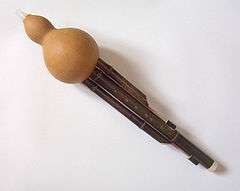Hulusi

 |
Hulusi
|
| Problems playing this file? See media help. | |
The hulusi (traditional: 葫蘆絲; simplified: 葫芦丝; pinyin: húlúsī) or cucurbit flute[1] is a free reed wind instrument from China. It is held vertically and has three bamboo pipes which pass through a gourd wind chest; the center pipe has finger holes and the outer two are typically drone pipes. It is not uncommon for a hulusi to have only one drone pipe while the second outer pipe is merely ornamental. The drone pipe has a finger hole, which allows it to be stopped. Advanced configurations have keyed finger holes similar to a clarinet or oboe, which can greatly extend the range of the hulusi to several octaves.
The hulusi was originally used primarily in Yunnan province by a number of ethnic-minority groups, in particular the Dai people who calls the instrument "bilangdao" (筚朗叨 – the word "bi" means woodwind instruments, the word "lang" means the instrument which is played vertically, and the word "dao" means gourd), and has gained nationwide popularity throughout China; similar to the popularity of the harmonica in the West, and "improved" versions have been produced outside of the indigenous realms.[2] [3] Like the related free reed pipe called bawu, the hulusi has a very pure, very mellow clarinet-like sound.
A similar instrument called hulusheng is a mouth organ with a gourd wind chest.
Etymology
The instrument's name comes from the Chinese words hulu, meaning "gourd," and si, meaning "silk" (referring to the instrument's smooth tone). The instrument is called bilangdao in the Dai language.
Performers
Although the hulusi is still predominantly performed in China, it has in recent years been adopted by European composers and performers. Rohan Leach from England, Rapheal De Cock from Belgium, Nadishana from Russia and Herman Witkam from the Netherlands have all taken the instrument in new directions.
References
- ↑ "The Cucurbit Flute". cultural-china.com. Retrieved 2009-04-22.
- ↑ http://www.patmissin.com/history/hulusi.html
- ↑ http://info.guqu.net/hulusizhishi/20060707233522_207.html
External links
- Hulusi page from Pat Missin site
- Hulusi page from ASZA.com site
Video
- Hulusi video from The Musical Instruments E-book
See also
- Bawu
- Traditional Chinese musical instruments
- Pungi, a similar Indian instrument